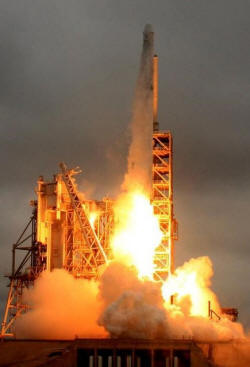|
SpaceX to launch first
reused rocket, testing cost-cutting model
 Send a link to a friend
Send a link to a friend
 [March 30, 2017]
By Irene Klotz [March 30, 2017]
By Irene Klotz
CAPE
CANAVERAL, Fla. (Reuters) - SpaceX is aiming for another space industry
first on Thursday when it plans to launch a Falcon 9 rocket that has
flown before, a key step in billionaire entrepreneur Elon Musk's quest
to cut the cost of space flight.
The rocket is scheduled to blast off at 6:37 p.m. EDT from the Kennedy
Space Center in Florida to deliver a communications satellite into orbit
for Luxembourg-based satellite operator SES SA.
Musk's SpaceX, formally known as Space Exploration Technologies Corp,
made history in December 2015 when it landed an orbital rocket for the
first time, a feat it since has repeated seven times.
By reusing rockets, SpaceX aims to cut its costs by about 30 percent,
the company has said. It lists the cost of a Falcon 9 ride at $62
million but has not yet announced a price for flying on a used rocket.
SES received a discount for joining the inaugural run, chief technical
officer Martin Halliwell told reporters this week, declining to specify
the cost.
Price alone was not the reason SES, with a fleet of 65 satellites,
decided to fly on a used rocket, he said.
"Someone has to go first," Halliwell said. "Really what we want to do
here is encourage the launcher industry to follow this way forward."
Proving the concept works is crucial to SpaceX, which is moving on from
an accident in September that damaged another Florida site.

SpaceX also is working on a passenger spaceship, with two unidentified
tourists signed up for a future trip around the moon. The company's
long-term goal under founder Musk is to fly people to and from Mars.
[to top of second column] |

A SpaceX Falcon 9 rocket lifts off on a supply mission to the
International Space Station from historic launch pad 39A at the
Kennedy Space Center in Cape Canaveral, Florida, U.S., February 19,
2017. REUTERS/Joe Skipper

For its 33rd mission, SpaceX is reusing a Falcon 9 booster that
originally flew in April 2016.
"We don't believe we're taking an inordinate risk here," said Halliwell,
noting that the rocket is in sufficiently good shape that its launch
insurance rates did not increase.
He declined to give the cost of the SES-10 satellite.
After sending the SES-10 satellite on its way to orbit, the rocket's
first-stage will turn around and attempt to land itself on an ocean
platform. If successful, SpaceX could fly the booster a third time, said
company spokesman John Taylor.
The rocket's second-stage, which is not recovered, will continue firing
to carry SES-10 into an initial egg-shaped orbit high above Earth. It
will provide TV and other communications services to Latin America.
(Reporting by Irene Klotz; Editing by Letitia Stein and Bill Trott)
[© 2017 Thomson Reuters. All rights
reserved.] Copyright 2017 Reuters. All rights reserved. This material may not be published,
broadcast, rewritten or redistributed.
 |